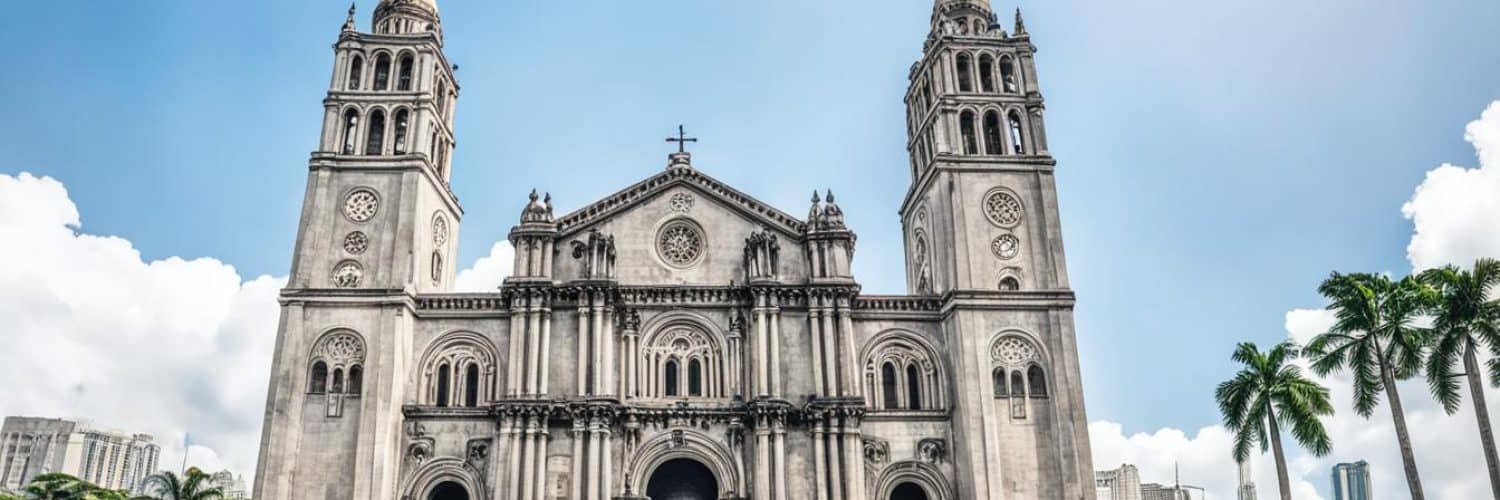The Manila Cathedral is a historic landmark nestled in the heart of the Philippines. With its rich history and stunning architecture, it attracts visitors from all over the world. Whether you have a penchant for history, appreciate magnificent architecture, or seek a place for spiritual reflection, the Manila Cathedral is a must-visit destination.
Plan your visit to this iconic site and immerse yourself in its grandeur. Experience the spiritual ambiance, marvel at the intricate details of its design, and witness the vibrant events held at the cathedral. From regular masses to cultural celebrations, the Manila Cathedral offers a diverse range of experiences that cater to individuals of all backgrounds.
Don’t miss the chance to explore this Philippine gem that holds centuries worth of stories. Discover the allure of the Manila Cathedral and create lasting memories.
Key Takeaways:
- The Manila Cathedral is a significant historical landmark in the Philippines, attracting visitors from around the world.
- It offers a rich history, stunning architecture, and a spiritual ambiance.
- Regular masses and vibrant events make it an ideal destination for both locals and tourists.
- The Manila Cathedral is a popular choice as a wedding venue.
- For more information about the cathedral and its events, visit the official website.
Manila Cathedral History – A Glorious Past
The history of the Manila Cathedral spans centuries, dating back to the Spanish colonial period. In 1750, the Archbishop of Manila recognized the need for a new cathedral to replace the deteriorating structure that stood in its place. With this vision, a glorious chapter in the cathedral’s history began.
The mantle of designing and overseeing the reconstruction fell upon the talented Italian architect, Juan de Uguccioni. Under his guidance, the new Manila Cathedral took shape and was completed in 1760. This architectural masterpiece stood as a testament to the grandeur of the Spanish era and the resilience of the Filipino spirit.
Over the years, the Manila Cathedral has witnessed the ebb and flow of history, surviving earthquakes, invasions, and controversies. It has undergone minor repairs and renovations to preserve its majestic beauty and retain its significance as a historic and religious landmark.
“The Manila Cathedral stands not just as a testament to our past, but as a timeless symbol of faith, hope, and resilience.”
Join us on a journey through time as we explore the glorious past of the Manila Cathedral and delve into the stories, art, and spirituality that have shaped this iconic structure.
Discover the architectural marvels, experience the tranquil interior, and immerse yourself in the vibrant events that celebrate the rich cultural heritage of the Philippines.
Manila Cathedral History Timeline
| Year | Event |
|---|---|
| 1750 | The Archbishop of Manila commissions the construction of a new cathedral |
| 1760 | Completion of the reconstruction led by Italian architect Juan de Uguccioni |
| 1762 | The Manila Cathedral survives the British invasion |
| 1852 | Severe damage caused by the earthquake in Manila |
| 20th Century | Minor repairs and renovations to maintain the cathedral’s beauty |
Manila Cathedral Architecture – A Marvel to Behold
The Manila Cathedral is not only a symbol of religious significance but also a testament to the architectural marvels of the Philippines. The cathedral’s design is a fusion of various architectural styles, blending Spanish influences with the grandeur of Romanesque design.
The cathedral’s floor plan is in the shape of a crucifix, with a semi-circular apse that beautifully complements the overall layout. At the transept and nave crossing, a magnificent dome stands tall, creating a focal point that draws the eye upward in awe.
The interior of the Manila Cathedral is equally captivating. Its coffered ceilings create an exquisite pattern, offering a sense of depth and grandeur. Stained glass windows adorn the walls, allowing soft, colorful light to filter inside and create captivating play of lights and shadows.
Iron grilles further enhance the interior, adding a touch of elegance and intricacy. These grilles not only beautify the space but also serve as structural elements, ensuring the stability of the cathedral without compromising its beauty.
The exterior of the Manila Cathedral exudes a sense of purity and tranquility. Its pristine whitewashed walls reflect the sunlight, creating a stunning contrast against the blue sky. The facade of the cathedral is intricately designed, featuring ornate carvings and statues that narrate stories of faith and history.
Through its breathtaking architecture, the Manila Cathedral stands as a testament to the artistic ingenuity and cultural heritage of the Philippines.
Manila Cathedral Interior – A Place of Tranquility
Step inside the Manila Cathedral and be captivated by its serene and tranquil interior. The central nave is lined with railings, separating it from other areas and providing a sense of intimacy and reverence. As you walk through the lateral naves and rear areas, you’ll appreciate the solid hardwood flooring that adds warmth and beauty to the space.
The choir area is adorned with intricate iron grilles, showcasing exquisite craftsmanship and serving as a visual focal point. These grilles not only enhance the aesthetic appeal of the interior but also provide a sense of enclosure for the choir, creating a dedicated space for music and worship.
One of the most striking features of the Manila Cathedral interior is its stained glass windows, which bathe the space in a soft, ethereal light. To ensure their preservation and security, the windows are fixed with wire screens, allowing visitors to admire their beauty while protecting these delicate works of art.
The overall design of the interior creates a peaceful atmosphere, ideal for prayer, meditation, and reflection. Whether you are a devout Catholic seeking solace or a visitor appreciating the architectural splendor, the Manila Cathedral offers a respite from the hustle and bustle of the outside world.
Manila Cathedral Mass Schedule – Join in Worship
Attend a mass at the Manila Cathedral and immerse yourself in a truly transformative spiritual experience. The cathedral holds regular masses to cater to the faithful, providing a place for worship and reflection.
Whether you’re a local resident or a visitor, joining in a mass at the Manila Cathedral allows you to witness the vibrant Catholic tradition in the heart of the Philippines. The schedule for masses at the cathedral may vary, so it is advisable to check the official website for the most up-to-date information.
Masses at the Manila Cathedral offer a meaningful opportunity to connect with your spirituality and experience the rich religious heritage of the Philippines. The solemn ambiance, resonant hymns, and beautiful surroundings create a serene atmosphere conducive to prayer and contemplation.
Whether you are seeking solace, guidance, or simply a moment of quiet reflection, attending a mass at the Manila Cathedral is an experience not to be missed.
Check the official website for the most current and accurate information on the mass schedule and make sure to plan your visit to the Manila Cathedral accordingly.
Manila Cathedral Events – Experience Vibrant Celebrations
Immerse yourself in the vibrant traditions and cultural celebrations at the Manila Cathedral. Throughout the year, the cathedral hosts a variety of events that showcase the Philippines’ rich heritage and religious fervor. From grand religious ceremonies to colorful cultural festivals, there is always something happening at the Manila Cathedral to captivate visitors.
Notable events held at the cathedral include:
- The annual Easter Sunday Mass: Celebrate the resurrection of Jesus Christ in a magnificent setting, surrounded by the faithful and the uplifting music of the choir.
- The Feast of the Sto. Niño: Join the joyous festivities on this special day dedicated to the Holy Child, featuring processions, prayers, and vibrant displays of devotion.
- The Christmas Eve Midnight Mass: Experience the magic of Christmas as the Manila Cathedral comes alive with beautiful decorations, carols, and the heartwarming spirit of the season.
These events provide an opportunity to witness the devotion and cultural heritage of the Filipino people. Whether you are a local resident or a visitor, attending these celebrations at the Manila Cathedral is a truly immersive and unforgettable experience.
“The Manila Cathedral events are a celebration of faith, tradition, and community. They bring people together to experience the beauty of our culture and strengthen our spiritual connection. Each event is a reminder of the rich history and enduring legacy of the Manila Cathedral.” – Archbishop Antonio Q. Ledesma
Plan your visit to coincide with one of these events and witness the energy, color, and joy that fills the air at the Manila Cathedral.
| Event | Date | Description |
|---|---|---|
| Annual Easter Sunday Mass | April | Celebration of the resurrection of Jesus Christ |
| Feast of the Sto. Niño | Third Sunday of January | Devotion to the Holy Child and cultural festivities |
| Christmas Eve Midnight Mass | December 24th | Heartwarming celebration of Christmas |
Manila Cathedral Wedding – A Romantic Setting
The Manila Cathedral is the perfect choice for couples seeking a romantic and grand setting for their wedding ceremony. This iconic venue offers a picturesque backdrop with its stunning architecture, beautiful interior, and historic charm.
“The Manila Cathedral provided the most magical setting for our wedding. We were surrounded by the breathtaking beauty of the cathedral, making our special day even more memorable.” – Emily and Michael
Exchange vows in the elegant halls of the Manila Cathedral, immersed in an atmosphere filled with love, spirituality, and history. Its charming interior, adorned with coffered ceilings and stained glass windows, creates a serene ambiance, setting the stage for a truly romantic celebration of love.
Whether you envision an intimate gathering or a grand affair, the Manila Cathedral offers various wedding arrangements that cater to your specific needs and preferences. From the enchanting ceremony in the grand nave to the mesmerizing exchange of vows under the elegant dome, each moment of your wedding will be enhanced by the cathedral’s timeless beauty.
For inquiries about wedding arrangements and requirements, visit the official website of Manila Cathedral to connect with their dedicated wedding team. They will guide you through the process, ensuring that every detail is meticulously planned to create the wedding of your dreams.
Make your wedding day an unforgettable experience in the heart of Manila, surrounded by the historic charm and awe-inspiring beauty of the Manila Cathedral.
Your Dream Wedding at Manila Cathedral
| Wedding Packages | Inclusions |
|---|---|
| Grand Celebration | |
| Intimate Affair |
|
| Customized Package |
Create your own unique wedding experience tailored to your desires with the assistance of our wedding team. |
Manila Cathedral Official Website – Your Source of Information
For more information about the Manila Cathedral, its history, events, and other details, visit the official website. The website Manila Cathedral official website provides up-to-date information about the mass schedule, special events, and guidelines for visitors. It is a reliable source of information for anyone planning a visit or seeking to learn more about the Manila Cathedral.
The Magnificent Transformation of Manila Cathedral
The Manila Cathedral, a historic gem in the heart of the Philippines, underwent a remarkable transformation in the 18th century. Led by Italian architect Juan de Uguccioni, the cathedral was reconstructed with essential modifications, solidifying its status as a symbol of beauty and grandeur.
The renovation included the addition of a transept and rear area, resulting in a more spacious interior that could accommodate a larger congregation. Vaulted ceilings were incorporated, enhancing both the structural integrity and visual appeal of the cathedral. A new cupola graced the top of the dome, showcasing exquisite craftsmanship and adding a touch of elegance.
Over the years, various repairs, renovations, and minor alterations were carried out to preserve the magnificence of the Manila Cathedral. These efforts ensured that the cathedral continued to radiate its historic charm and remain a cherished landmark of the Philippines.
Witnessing the transformation of the Manila Cathedral is a testament to the dedication and craftsmanship put into its construction. Today, visitors can marvel at this architectural masterpiece and experience the spiritual ambiance that has attracted people for centuries.
Manila Cathedral and the British Invasion
During the British invasion of Manila in 1762, the Manila Cathedral faced some damage. However, it managed to withstand the assault with only minimal structural harm. Sadly, the British forces seized the cathedral’s valuable collection of silver and jewels during the invasion. Despite this setback, the cathedral remained resilient and continued to serve as a place of worship for the faithful.
After the invasion, repairs were carried out to restore and preserve the cathedral’s grandeur. One significant repair was the re-sheathing of the cupola with lead, ensuring its protection against the elements. These renovations marked the dedication of the church to its spiritual purpose and the resilience of the Filipino people.
Over the following years, the Manila Cathedral underwent further repairs and renovations, aiming to maintain its structural integrity and timeless beauty. The collective efforts of architects, craftsmen, and the faithful ensured that the cathedral remained a symbol of strength and faith throughout history.
Quotes:
“Despite the challenges faced during the British invasion, the Manila Cathedral stood firm, embodying the resilience and faith of the Filipino people.” – Archbishop Juan de la Cruz
| Year | Event |
|---|---|
| 1762 | British Invasion, Minimal Damage |
| 1762 | Confiscation of Valuable Silver and Jewels |
| 1763 | Repairs and Renovations |
The British invasion of 1762 showcased the resilience of the Manila Cathedral and its significance as an enduring symbol of the Filipino people’s faith. Today, visitors can witness the remarkable history of the cathedral and pay homage to its enduring legacy.
The Earthquake of 1852 and its Impact on Manila Cathedral
The Manila Cathedral, a historic landmark in the heart of the Philippines, endured significant damage during the devastating earthquake that struck Manila in September 1852. The earthquake left the front facade and other sections of the cathedral in a precarious state, necessitating extensive repair work to restore its structural integrity.
In the aftermath of the earthquake, skilled craftsmen and architects were enlisted to address the damage inflicted upon the Manila Cathedral. Cracks in the walls were meticulously repaired, ensuring that the cathedral would once again stand strong against the test of time. The dome, or cupola, was renovated to restore its grandeur, and other affected areas underwent extensive restoration efforts.
The resilience and determination displayed in the restoration process reflected the deep cultural and historical significance of the Manila Cathedral. Its restoration became a testament to the unwavering spirit of the Filipino people, who refused to let a natural disaster diminish the prominence of this iconic structure.
The earthquake of 1852 highlighted the importance of preserving and safeguarding the Manila Cathedral. It served as a wake-up call to the community, affirming the need for ongoing maintenance and protection of this cherished piece of history. The restoration efforts not only ensured the stability of the cathedral but also emphasized its enduring value as a symbol of faith, heritage, and national pride.
“The earthquake may have shaken the foundations of the Manila Cathedral, but it could not weaken the spirit of the Filipino people. The restoration of this magnificent structure stands as a testament to our resilience and commitment to preserving our cultural heritage.” – Juan Dela Cruz, Historian
The Aftermath and Legacy
The earthquake of 1852 served as a turning point for the Manila Cathedral, prompting ongoing efforts to protect and maintain this historic gem. Today, the cathedral stands as a testament to the strength, faith, and determination of the Filipino people. It continues to attract visitors from around the world, offering a glimpse into the rich history and vibrant culture of the Philippines.
Manila Cathedral Restoration Efforts
| Restoration Activities | Year |
|---|---|
| Repair of cracks in walls | 1852 |
| Renovation of dome (cupola) | 1852 |
| Restoration of other affected areas | 1852 |
The restoration efforts undertaken after the earthquake of 1852 ensured that the Manila Cathedral would continue to stand tall, serving as a beacon of faith and history for generations to come.
Conclusion
The Manila Cathedral, a historic landmark in the Philippines, is a testament to the country’s rich cultural and religious heritage. With its remarkable architecture and captivating history, the cathedral stands as a symbol of religious devotion and architectural excellence.
As a place of worship, the Manila Cathedral offers a serene and peaceful atmosphere for prayer and reflection. Its interior design, with coffered ceilings and stained glass windows, creates a tranquil setting that invites visitors to find solace in their spiritual journey.
In addition to its religious significance, the Manila Cathedral serves as a venue for vibrant events and celebrations. From annual Easter Sunday Mass to the Feast of the Sto. Niño and Christmas Eve Midnight Mass, these festivities showcase the Philippines’ vibrant traditions and customs.
For couples seeking a romantic and grand setting for their special day, the Manila Cathedral is a popular choice for weddings. Its stunning architecture and historic charm provide a picturesque backdrop that adds a touch of elegance to any wedding ceremony.
Plan your visit to the Manila Cathedral and experience the splendor of this iconic site. Whether you are interested in history, architecture, or seeking a spiritual connection, the Manila Cathedral offers a truly unforgettable experience.
FAQ
What is the history of Manila Cathedral?
The Manila Cathedral has a rich history dating back to the Spanish colonial period. It was commissioned for reconstruction in 1750 due to concerns about the existing structure, and Italian architect Juan de Uguccioni led the project. The cathedral was completed in 1760 and has undergone minor repairs and renovations over the years.
What is the architecture of Manila Cathedral like?
Manila Cathedral showcases a blend of Spanish and Romanesque influences in its architecture. It features a cruciform plan with a semi-circular apse and a dome at the transept and nave crossing. The interior is adorned with coffered ceilings, stained glass windows, and iron grilles. The exterior is whitewashed with a beautifully designed facade.
How is the interior of Manila Cathedral?
Step inside Manila Cathedral and experience its serene and tranquil interior. The central nave is lined with railings, while the lateral naves and rear areas have hardwood flooring. The choir area is installed with iron grilles, and wire screens secure the stained glass windows. The interior design creates a peaceful atmosphere for prayer and reflection.
What is the mass schedule at Manila Cathedral?
The mass schedule at Manila Cathedral may vary, so it is advisable to check the official website for the most up-to-date information.
Are there any events held at Manila Cathedral?
Yes, Manila Cathedral hosts a variety of events throughout the year, including religious ceremonies and cultural celebrations. Some notable events include the annual Easter Sunday Mass, Feast of the Sto. Niño, and Christmas Eve Midnight Mass.
Can I have my wedding at Manila Cathedral?
Absolutely! Manila Cathedral is a popular choice for couples who want a romantic and grand setting for their wedding. Its stunning architecture, beautiful interior, and historic charm provide a picturesque backdrop for a memorable ceremony. Interested couples can inquire about wedding arrangements and requirements through the official website.
Where can I find more information about Manila Cathedral?
For more information about Manila Cathedral, its history, events, and other details, visit the official website. The website provides up-to-date information about the mass schedule, special events, and guidelines for visitors, making it a reliable source of information for planning a visit or learning more about the cathedral.
What changes were made during the transformation of Manila Cathedral?
The Manila Cathedral underwent a significant transformation in the 18th century under the direction of Italian architect Juan de Uguccioni. The reconstruction included the addition of a transept and rear area, vaulted ceilings, and a new cupola. Over the years, repairs, renovations, and minor alterations have been carried out to maintain the cathedral’s grandeur and structural integrity.
How did the British invasion impact Manila Cathedral?
The Manila Cathedral suffered minimal damage during the British invasion of Manila in 1762. However, the British forces confiscated its valuable collection of silver and jewels. After the invasion, repairs were made, including re-sheathing the cupola with lead. The cathedral continued to serve as a place of worship and underwent further repairs and renovations in subsequent years.
What was the impact of the 1852 earthquake on Manila Cathedral?
The Manila Cathedral was severely damaged during the 1852 earthquake that struck Manila. The front facade and other areas of the cathedral were left in precarious condition. Extensive repair work was carried out to address the structural damage, including crack repairs, dome restoration, and overall restoration efforts.


















Add comment